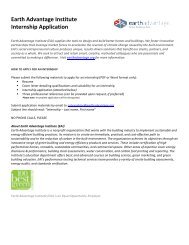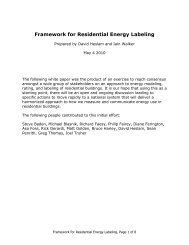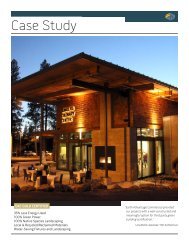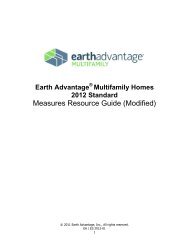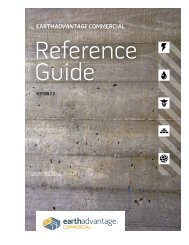EA New Homes Measures Guide - Earth Advantage
EA New Homes Measures Guide - Earth Advantage
EA New Homes Measures Guide - Earth Advantage
You also want an ePaper? Increase the reach of your titles
YUMPU automatically turns print PDFs into web optimized ePapers that Google loves.
2012 <strong>Earth</strong> <strong>Advantage</strong> Residential<br />
<strong>Measures</strong> Resource <strong>Guide</strong><br />
4.3.9<br />
Non-ducted System<br />
Energy<br />
Materials<br />
Water<br />
0 3 0 3 0<br />
Description: Designing the house with a non-ducted heating or cooling system. Systems that should receive these points are ductless heat<br />
pumps, hydronic heat, and zonal electric.<br />
Health<br />
Land<br />
Benefit: Duct systems account for a very large amount of the energy used in buildings. Much of the impact is direct heat loss and air<br />
leakage from the ducts. However, large furnace blowers also create pressure differences throughout the building that contribute to building<br />
air leakage. These imbalances can also pull moisture, allergens, and harmful soil gases into the house or create moisture problems in<br />
building cavities. Forced air heating systems and the associated ductwork also consume a considerable amount of valuable space.<br />
Verification: <strong>EA</strong> Rater will confirm a non-ducted heating system on the plans and during site visits.<br />
4.3.10<br />
Zonal Pressure Relief (ZPR) for ducted systems<br />
Energy<br />
Health Land Materials<br />
Prerequisite<br />
Description: A properly-installed HVAC duct system balances house pressures through all living spaces of the house. Air must have an<br />
unobstructed path from each supply register to the return grille. Zonal pressure relief is required in any room that is 75 square feet or<br />
larger, has a supply register, and has a door. Pressure relief can be provided in several ways. 1) Cut the bottom of the door to allow a full<br />
one-inch space between the bottom of the door and the top of the finished flooring. 2) Install a transfer grille through the wall. 3) Install a<br />
transfer duct from the room into the central zone. 3) Install a direct return in each room. The goal of pressure relief is to maintain a<br />
pressure difference across the door of no more than 3 Pa. Door undercuts are effective only in smaller rooms with only one supply. In<br />
rooms with more than one supply, a transfer duct or direct return is usually the most effective method.<br />
Water<br />
Benefit: Forced-air heating systems include large blowers to move conditioned air through the house. Ideally, all the air that is delivered to<br />
the house through supply registers flows through the house to the central return. Unfortunately, interior doors block the ideal air flow and<br />
create severe pressure imbalances. Supply air is ?bottled up? behind bedroom doors, while other areas are starved for air. Pressure<br />
problems in houses can also cause naturally-vented combustion appliances to back-draft, which brings harmful flue gasses into the<br />
building. Systems with adequate pressure relief provide better safety, comfort, and efficiency.<br />
Verification: For ducted systems, <strong>EA</strong> Rater will identify the method of zonal pressure relief for each room (usually bedrooms) and will<br />
measure zonal pressure. The pressure difference of each bedroom with respect to the main living area (or hallway) must not exceed +5 Pa.<br />
4.3.11<br />
Pre-fabricated Sealed Boot<br />
Energy<br />
Materials<br />
Water<br />
0 1 0 0 0<br />
Description: A pre-fabricated sealed boot is a mounting system that allows air supply boots to be tightly sealed to a ceiling, wall, or sub<br />
floor. (A boot is the termination that connects a round duct to a rectangular grille opening.) Some models come with an adjustable boot<br />
hanger that quickly attaches between joists, trusses, or studs. A foam gasket provides a tight seal to the drywall or sub floor. A cardboard<br />
cover prevents dirt and debris from entering the duct during construction. It is most common to use this product in the ceiling.<br />
Health<br />
Land<br />
Benefit: This product can save labor, keep ducts clean, and reduce air leakage.<br />
Verification: <strong>EA</strong> Rater will visually verify the presence of pre-fabricated sealed boots.<br />
4.4 Air Quality<br />
Page 37 of 70



